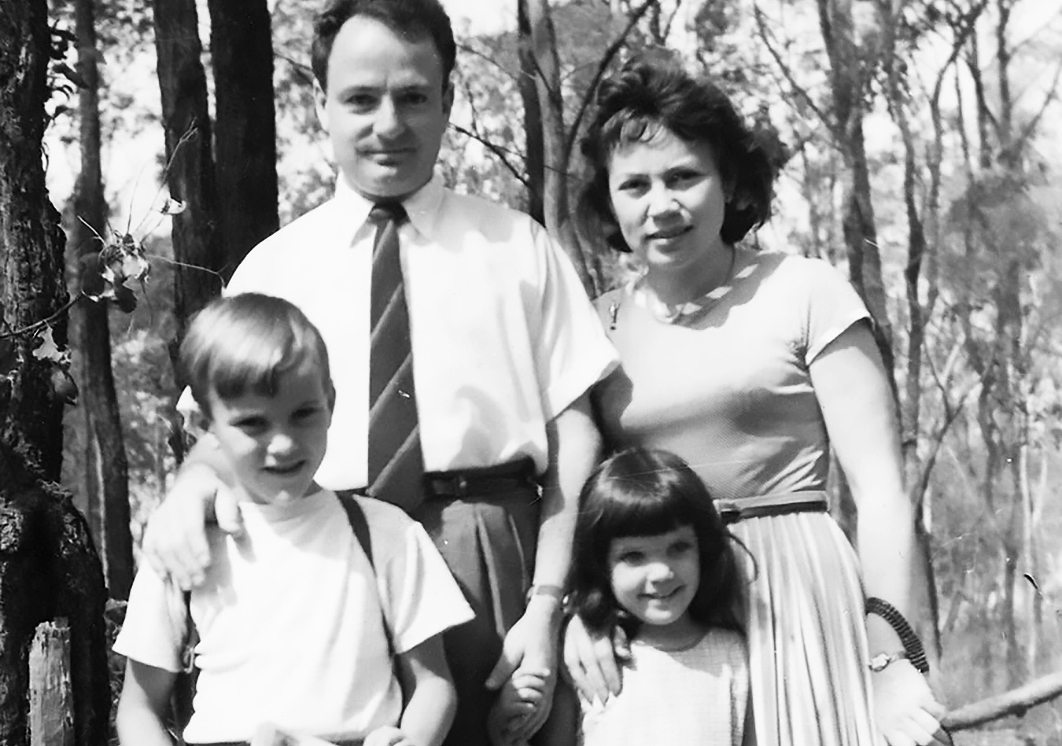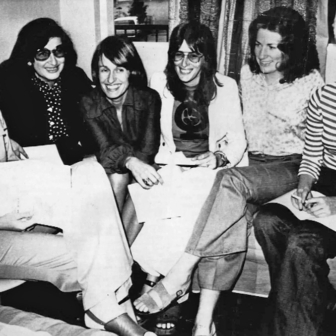Until 1966, women employed in the Australian public service were faced with a choice that is difficult to comprehend today. Under the “marriage bar” they were required to give up their jobs once they married, leaving many women with only two choices: relinquish paid work or attempt to conceal their marital status.
Secrecy could be difficult to maintain: an informer, a pregnancy or an accidental revelation might bring the deception to an ignominious end. Women’s rights campaigner Merle Thornton tells of a friend who worked at the desk next to hers in the Department of Social Services. Having secretly married, she was exposed when a caller to the section asked for her by her married name. No help was forthcoming from the union, the Administrative and Clerical Officers’ Association; in fact, the ACOA was among the strongest supporters of the bar.
Typists, whose work was regarded as unsuitable for men, were allowed to return as temporary staff members after marriage. But only permanent officers could occupy supervisory positions, so the possibilities for married women were extremely limited. They had few entitlements and forfeited their superannuation rights. Even single women suffered, missing out on training because it was assumed they would marry and thus waste and extra knowledge or skills they picked up.
The 1942 book Public Service Recruitment in Australia expressed a view of women employees that was typical of the time:
There is some evidence that they are more adaptable to monotonous work than men. Women are still prepared to undertake such work at comparatively low salaries, and their retirement upon marriage is still an important factor ensuring rapid turnover, thus mitigating the problem of blind-alley employment.
The author was Robert Parker, an expert in public administration who would play a significant part in the removal of the marriage bar that seemed so natural to him when he wrote those words. One of his stepdaughters, Meredith Edwards, would later become deputy secretary of the Department of Prime Minister and Cabinet.
In the late 1950s, Parker was a key member of a committee of inquiry into public service recruitment chaired by former ABC chairman Richard Boyer. One of the many submissions to the inquiry came from the Canberra Association of Women Graduates, which had surveyed women graduates in the public service and found that the marriage bar and the lack of equal pay were major issues of concern. Women also struggled with prevailing prejudices, such as the view that it was inappropriate for women to supervise men. Senior officers in the Department of Supply also reported to the Boyer committee that they were embarrassed by their inability to promote good female clerks because of their restriction to positions without supervisory responsibilities.
Educator and feminist Helen Crisp was one of the two representatives from the Association of Women Graduates who appeared before the all-male committee. She later said that she left the hearing “full of hope” but, on reflection, thought that their good reception was due to the fact that the committee had already intended to recommend the removal of the marriage bar and was glad of the association’s evidence and support. In fact, the committee’s minutes make clear thatthe association’s evidence was instrumental in convincing it to take up the issue of women’s employment and ask Robert Parker to prepare a paper on the subject. The committee decided, however, that equal pay was outside its terms of reference: “While unequal pay for the sexes obtains in the private sector it cannot be regarded as a deterrent to employment in the Public Service.”
Among its wide-ranging recommendations for the modernisation of public service recruitment, the Boyer committee did, indeed, formally recommend the removal of the marriage bar. Notably, it put the argument in terms of women’s citizenship rights, as well as advantage to the service.
Parker foreshadowed the recommendations in a paper to a national conference on public service recruitment, shortly before the report’s release in 1958. The only woman present to hear Parker’s views on female recruitment, among over one hundred delegates, was, again, Helen Crisp. Her husband, political scientist L.F. Crisp, was the president of the Canberra group of the Royal Institute of Public Administration, which was hosting the conference. The conference was formally opened with the salutation “Mrs Crisp and gentlemen.”
“In so far as the peculiarities of females render them unsuitable or uneconomical to employ in certain occupations or certain positions,” said Parker, “the public service may have perfectly rational grounds for limiting their employment in those positions, on the valid principle of suiting persons to jobs.” He went on:
But it is perfectly clear that some public service authorities – or at least some governing legislation – go further than this, and presume to decide whether women in accepting employment are evading their domestic responsibilities. In my view, this is a matter for individuals, not the State to decide.
He later referred more forthrightly to the “arbitrary wastage of female talent in the community.” While Parker was still referring to peculiarities that might limit the kinds of jobs for which women were suited, he was firmly contesting the use of the Public Service Act to enforce a certain kind of public morality that laid down home duties as the only appropriate occupation for married women. He had come a long way since 1942.
But while the government introduced legislation for most of the Boyer committee’s recommendations in late 1960, it deferred action on married women, pending a report from the Public Service Board.
When it reported to cabinet in 1961, the Public Service Board supported the Boyer recommendation. Cabinet still, however, decided to take no action on the matter. The reason for cabinet’s 1961 decision, and a subsequent 1962 reaffirmation of it, was the belief that “the Australian social structure would be best served if there were no change, and that the Commonwealth Government should not lead in encouraging married women away from their homes and into employment.”
But cabinet’s decision was not for public consumption. Prime minister Robert Menzies told parliament that the board’s report was “still under consideration.” Cabinet decided that the government’s line for the purposes of parliament and the forthcoming federal election was that “the question is one to which the Government has been giving some consideration but concerning which it has not yet come to a conclusion.” As John Bunting, secretary to cabinet and head of the prime minister’s department, put it at the time, cabinet decided to lie low for the time being, rather than provoke the feminists.
By 1965, the government still had not acted, but the issue got a new lease on life from the apparently unrelated issue of women’s right to drink in the public bars of hotels. In March 1965, Merle Thornton and Rosalie Bogner chained themselves to the public bar in the Regatta Hotel in Brisbane, from which women were banned. There was enormous media coverage, with reports appearing as far away as Moscow and London, and an interview on the new and influential Four Corners program on ABC television. Thornton had been forced to resign from her job with the ABC halfway through her first pregnancy, after two years of concealing her marriage. She took advantage of the publicity, and the large number of people who had contacted her, to found the Equal Opportunities for Women Association, or EOW, the primary goal of which was the removal of the Commonwealth marriage bar.
EOW set about lobbying and producing material relevant to its case. In particular, it sought to contest arguments about the negative effects on children of maternal deprivation, and the relationship between maternal absence and juvenile delinquency. It also collected the personal testimonies of women whose lives had been damaged by the marriage bar. As Thornton has pointed out, this emphasis on the authenticity of women’s own experience foreshadowed, as did the direct action on behalf of women’s rights, the arrival of women’s liberation later in the decade.
Bill Hayden, federal member for Oxley, was recruited and, armed with EOW’s research and arguments, began doggedly raising the issue in the federal parliament, including in a major speech in October 1965 and a private member’s motion in December.
Meanwhile, behind the scenes, the bureaucracy was also stirring. The chairman of the Public Service Board was the formidable strategist Fred Wheeler (later Sir Frederick). Wheeler had spent the 1950s in Geneva as treasurer of the International Labour Organization and so was very familiar with international standards on issues such as the employment of married women. In 1961, he had recommended to cabinet that the marriage bar be lifted. He now suggested to the head of the Department of Labour and National Service that it might again raise the matter with cabinet. Significantly, although the public service came within Prime Minister Menzies’s portfolio, Wheeler did not try this route.
The minister for labour and national service, William McMahon, put forward a cabinet submission on 30 November recommending removal of the marriage bar on the grounds of labour shortages and the international embarrassment it caused, particularly with the ILO. The submission cited support from sections of the Liberal Party, female Liberal senators, the National Council of Women, and other women’s organisations. The federal Labor Party had adopted the removal of the marriage bar as part of its policy; and major public service organisations such as the Professional Officers’ Association and ACOA were also in favour. ACOA had withdrawn its opposition to the retention of married women as permanent officers, though it still objected to the recruitment of married women.
But there was resistance from the prime minister’s department, which raised a number of concerns about McMahon’s submission, among them the potential that married women, with their divided loyalties, might not be fully efficient: “Given that married women may at times have a conflict of loyalties between work and family responsibilities, what regulating action can be taken to ensure that the Service does not come off second best?” The department also drew attention to the distinction between retention of married women and their active recruitment “in competition with normal recruitment.”
Eventually, cabinet deferred the decision yet again, referring the issue of permanent employment of married women to an interdepartmental committee, which it asked to examine the consequences of such a decision both within and outside the service.
Hayden persisted with his parliamentary questions, but it was the retirement of Menzies in January 1966 that removed the last major obstacle to progress. Leslie Bury, the new minister for labour and national service, presented a cabinet submission in August 1966 reporting on the findings of the interdepartmental committee and recommending action in the current session of parliament to remove the marriage bar. Cabinet at last agreed on such action on 24 August 1966.
The minister recommended that the Act make it clear that “married women officers are subject to the same conditions as other officers and therefore subject to dismissal if, on account of domestic responsibilities, they fail to observe those conditions.” Cabinet concurred. The removal of the marriage bar in the United Kingdom in 1946 had come with a similar provision:
H.M. Government has taken this decision on the understanding that steps will be taken to dismiss from the Civil Service any married woman who on account of domestic responsibilities or for any other reason fails to observe the conditions of service of her grade according to normal departmental agreements and practices.
Married women were to be treated like everybody else; there was not yet any consideration of the need to review employment arrangements to ensure they did not discriminate against officers with family responsibilities. That had to wait for two decades. Moreover, retention of married women was regarded in a different light from their recruitment; the latter was to be kept under review.
The bill removing the marriage bar completed its passage through parliament on 28 October, just before the 1966 federal election. It came into effect on 18 November 1966. It was a far cry from the state of affairs earlier in the decade, when even the public servants’ own union believed that “the majority of Commonwealth public service positions above the base grades will remain inherently more suitable for male officers.” •
This article is based on the introduction to Removal of the Commonwealth Marriage Bar: A Documentary History, edited by Marian Sawer (Centre for Research in Public Sector Management, University of Canberra, 1997).
• More articles in our series on the landmark events of 1966




